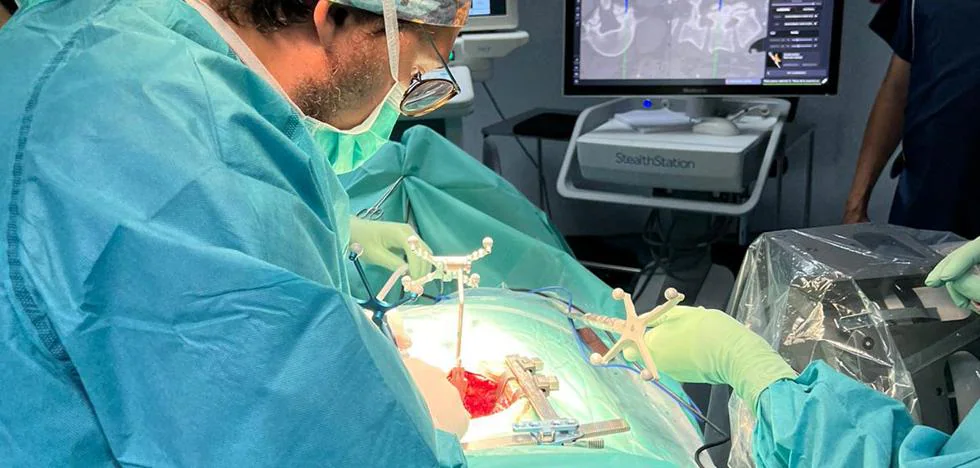Neurosurgeon Marín Laut intervenes on a patient. /
La Arrixaca introduces neuronavigation in surgeries to correct vertebral fractures or degenerative processes
GPS in the car has long helped us move around cities without getting lost. But surgeons also have their own navigation systems, which allow them to know with millimeter precision where to make an incision or place a prosthesis. It is neuronavigation, which began to be used years ago to intervene in brain tumors and has just been applied for the first time in the Region of Murcia in complex spinal surgeries.
The initiative came from the Arrixaca Neurosurgery Service and, in particular, from the neurosurgeon Francisco Miguel Marín Laut, who was trained in this technology in Germany. “There it was used daily. The main advantage of neuronavigation is that it reduces the need for reinterventions. Sometimes, in spine surgery you have to operate again because some material has not been placed in the exact place. That risk practically disappears”, explains Marín Laut.
In this type of surgery, the doctor intervenes with the help of three-dimensional images in real time. The patient undergoes a fine-cut CT scan, which provides “many images”, from which the computer system reconstructs the anatomical structures. But, in addition, during the operation, an optical system allows the exact location of the materials and instruments to be transferred to the computer, so that the program precisely “recalculates” the place in which it is intervening. To do this, the surgeon points out the area of interest with a laser pointer.
In short, it is a system “similar to a GPS”, with a reconstruction from reference points that the program relates spatially.
The image offered by the neuronavigator during the operation. /
Two interventions
Marín Laut has already carried out the first two spinal interventions using neuronavigation, but this is only the beginning. It will be used, on the one hand, to operate on vertebral fractures after trauma. Also for osteosynthesis or arthrodesis surgery, in degenerative spine pathology. Specifically, in severe disc diseases, which affect the intervertebral discs, “when conservative treatment has not come to fruition”; in spondylolisthesis (when the vertebra moves instead of remaining fixed in its proper position); and in foraminal or lumbar canal stenosis (when the spaces in the spine narrow and put pressure on the spinal cord and spinal nerve roots).
in concerted
The Arrixaca has neuronavigation equipment that will be used in the hospital and another device that can be moved around the concerted centers, where degenerative spine surgery is mostly carried out.
Traditionally, neurosurgeons have needed the image provided by X-ray devices during the operation to advance on the area in which they are intervening. But, unlike neuronavigation, this provides “two-dimensional images”, which are not as precise, and also entails exposure to radiation, both for the patient and for the professionals, which can be avoided once the new technique is perfected. However, for the time being, ray devices are still being used as support.
The technology has been used for years to intervene in brain tumors, but it is the first time that the regional public health system has applied it to this other field
Marín Laut is convinced that navigation will extend beyond the Neurosurgery service. It is also beginning to be implemented in other communities, although at the moment Spain is behind countries such as Germany.
In the Murcian Health Service they emphasize that, “thanks to the precision provided by neuronavigation in spinal surgery, almost one hundred percent non-reoperation of the patient can be ensured”, which “can contribute to improving the list of expectation” of patients who need these interventions.
#GPS #operate #column



Leave a Reply